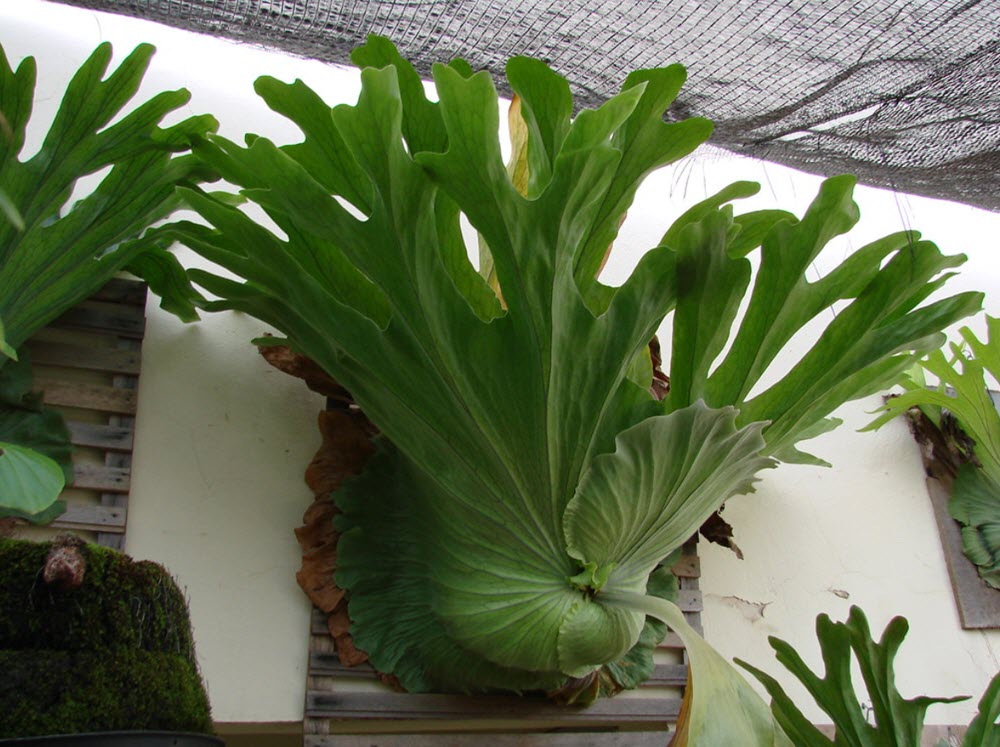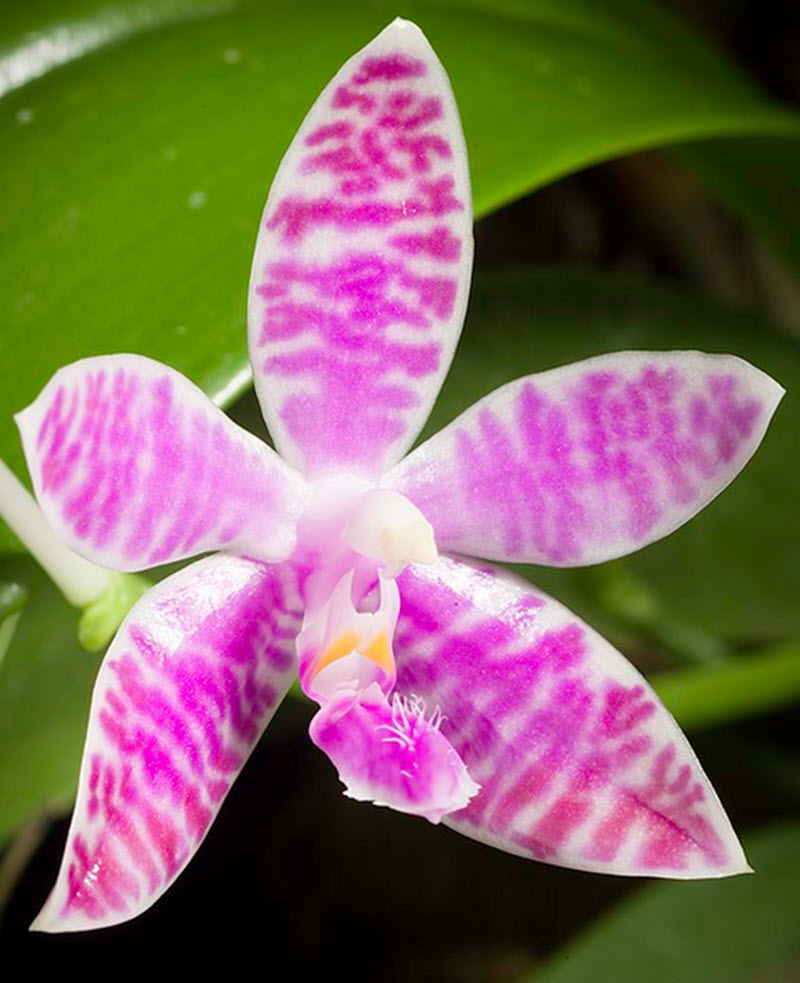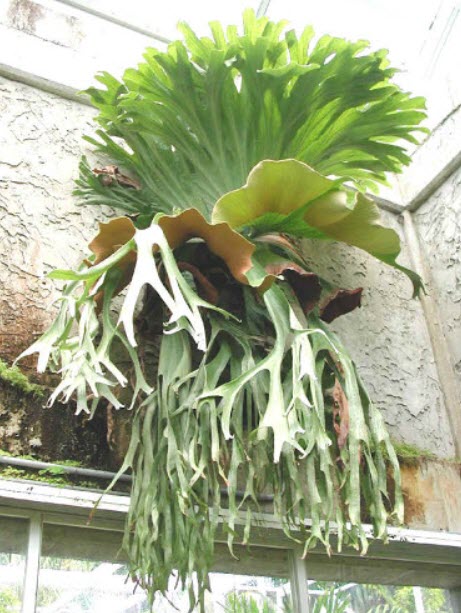Contents
In its native Philippines, the Giant staghorn fern (Platycerium grande) grows on tree branches, fallen logs, stones and similar. This is not a parasitic plant; it is an epiphyte and it uses tree branches etcetera as support only – it doesn´t take water or nutrients from the living tree. The green fronds carry out photosynthesis, while the brown fronds near the base traps falling debris such as dead spiders and insects, and plant material. From this trapped debris, the fern obtains minerals and other nutrients, since it doesn´t grow in soil.

Short info
Common English name: Giant staghorn fern
Common Filipino name: Dapong repolyo (“Air cabbage”)
Common Spanish name: Capa de leon (“Lion´s cape”)
Family: Polypodiaceae
Shape: Climbing
Height: Up to 90 cm
Foliage: Green
Light: Bright
Temperature: 18°C to 24°C during the growth period, 13°C to 18°C during the resting period
Watering: Plenty during the growth period, sparingly during the resting period
Air humidity: High
Description
The Giant staghorn fern develops two type of fronds and both can become large. The sterile fronds grow to look like shields. The sterile fronds, which can be up to two meters in length, are two-lobed and features long hanging “fingers”.
Distribution and habitat
Platycerium grande is an epiphyte native to the Philippines, where it grows on tree branches, rocks and other suitable surfaces in the forest. In Filipino, its name is dapong repolyo, which means “tree cabbage”. It is one of two staghorn ferns native to the Philippines, with the other one being Platycerium coronarium. It is often found growing in the same area as Phalaenopsis Mindanao and other Phalaenopsis species native to the Philippines. Renanthera, Vandas, Aerides, Trichoglottis and Dendrobiums orchids are also found in the same areas as Platycerium grande.

In the Philippines, Platycerium grande is endemic to the island Mindanao where it is found in the provinces Zamboanga, Lanao and Davao.
Keeping a Platycerium grande
This is an epiphyte
 Platycerium grande doesn´t grow in the ground in the wild. It is an epiphyte that grow on tree branches, rocks and similar. In the trade, giant staghorn fern is often sold growing on a piece of wood or bark. If you buy a plant that is planted in soil instead, it is a good idea to transplant it to something better, since being planted in the soil isn´t natural for this fern.
Platycerium grande doesn´t grow in the ground in the wild. It is an epiphyte that grow on tree branches, rocks and similar. In the trade, giant staghorn fern is often sold growing on a piece of wood or bark. If you buy a plant that is planted in soil instead, it is a good idea to transplant it to something better, since being planted in the soil isn´t natural for this fern.
When the fern´s fronds have almost covered the material they are attached to, the plant needs something bigger to grow on. Instead of trying to remove the original attachment, simply nail or tie the attachment to a bigger piece. The fern can then gradually spread onto the larger piece.
If you have a dislocated Giant staghorn fern that you need to attach to something, make a mixture of very coarse peat moss and sphagnum moss. Wrap the root mass to the moss to create a bundle. Tie the bundle to the attachment using strong cotton thread. Keep both moss and roots moist at all times until the plant has attached itself to the attachment.
Some growers keep their giant staghorn ferns in wooden slatted hanging baskets instead. Fill the basked with coarse peat moss and sphagnum moss – not soil. The fronds will gradually attach themselves to the basket, making it difficult to transplant the fern to a larger basket when it has outgrown this one.
Light and position
In the wild, this fern grows in tree branches in the Philippines and is adapted to bright light that filters through the canopy. Strong direct sunlight should be avoided, since it will make the fronds lose much of their strong green colour.
Temperature
The recommended ranges are 18°C to 24°C during the growth period, and 13°C to 18°C during the resting period.
When the temperature exceeds 20°C, it is important to provide extra air humidity.
Watering
Give the fern plenty of water during the growth period, and only water sparingly during the resting period.
During the growth period, each watering should make the roots and the attachment material completely moist. Then, allow it to dry out almost completely before you water again. Remember, this is a plant that grows in stones and tree branches in the wild. It is not adapted to standing with its roots in soggy soil. If the “shield frond” covers the surface, submerge the root portion (and attachment material) of the plant in a bowl of water for 15 minutes instead of doing a traditional watering from above.
During the resting period, water only enough to keep the roots and attachment material barely moist. When the fronds become extra droopy, it is time for another watering. If it is impractical to water from above, soak the roots and attachment material in a bowl water for 2 minutes.
Humidity
Platycerium grande likes high humidity and enjoys having its fronds misted every morning. Soft water is preferable to hard water.
Nutrients
Do not pour fertilizer directly on the plant. The best way of fertilizing is to use the above described “dunking method” instead of traditional watering, and add some liquid fertilizer to the dunking water once in a while. It is important to not dunk is a strong fertilizer solution.
Mature and well-established plants will not require frequent dunks in fertilizer, especially not if they grow on organic material such as bark or wood. During the whole period of active growht, two or three fertilizer-dunks are usually enough. For less established plants, especially if grown on a material that will not absorb and slow-release nutrients, the recommendation is to feed once a month during the active growth period.
